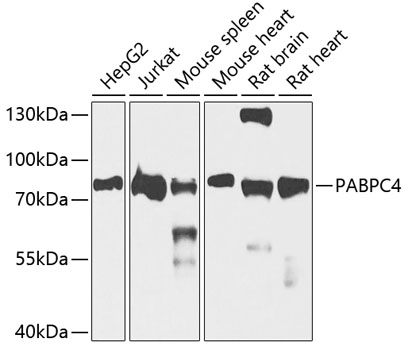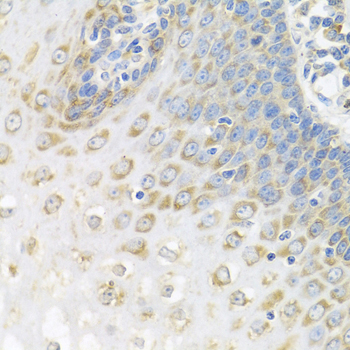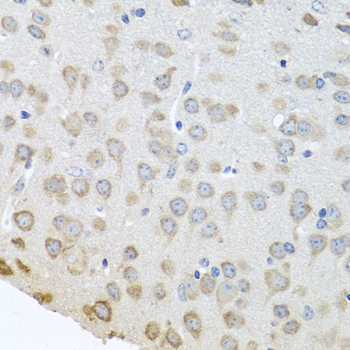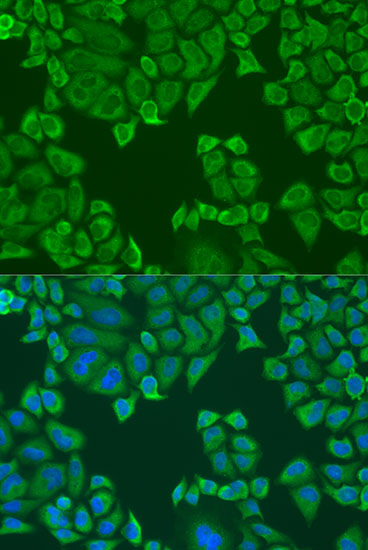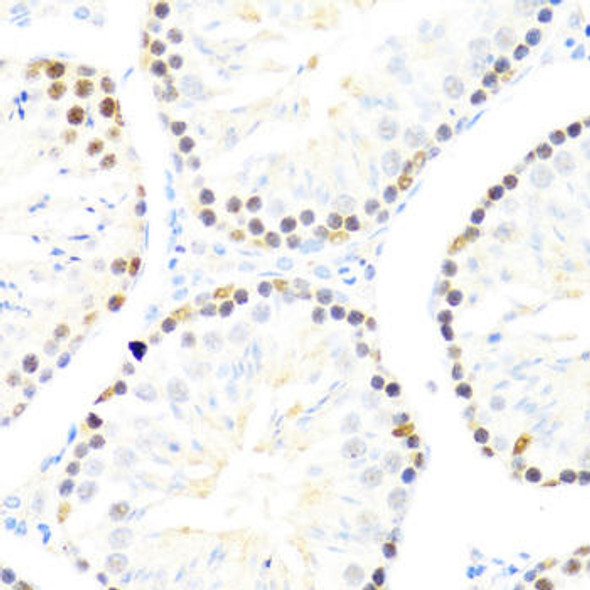Cell Biology Antibodies 9
Anti-PABPC4 Antibody (CAB5948)
- SKU:
- CAB5948
- Product Type:
- Antibody
- Reactivity:
- Human
- Reactivity:
- Mouse
- Reactivity:
- Rat
- Host Species:
- Rabbit
- Isotype:
- IgG
- Antibody Type:
- Polyclonal Antibody
- Research Area:
- Cell Biology
Description
| Antibody Name: | Polyclonal AntibodyPC4 Rabbit Polyclonal Antibody |
| Antibody SKU: | CAB5948 |
| Antibody Size: | 20uL, 50uL, 100uL |
| Application: | WB IHC IF |
| Reactivity: | Human, Mouse, Rat |
| Host Species: | Rabbit |
| Immunogen: | A synthetic peptide corresponding to a sequence within amino acids 350-450 of human PABPC4 (NP_003810.1). |
| Application: | WB IHC IF |
| Recommended Dilution: | WB 1:500 - 1:2000 IHC 1:50 - 1:200 IF 1:50 - 1:200 |
| Reactivity: | Human, Mouse, Rat |
| Positive Samples: | HepG2, Jurkat, Mouse spleen, Mouse heart, Rat brain, Rat heart |
| Immunogen: | A synthetic peptide corresponding to a sequence within amino acids 350-450 of human PABPC4 (NP_003810.1). |
| Purification Method: | Affinity purification |
| Storage Buffer: | Store at -20'C. Avoid freeze / thaw cycles. Buffer: PBS with 0.02% sodium azide, 50% glycerol, pH7.3. |
| Isotype: | IgG |
| Sequence: | VTEM NGRI VGSK PLYV ALAQ RKEE RKAH LTNQ YMQR VAGM RALP ANAI LNQF QPAA GGYF VPAV PQAQ GRPP YYTP NQLA QMRP NPRW QQGG RPQG FQGM P |
| Gene ID: | 8761 |
| Uniprot: | Q13310 |
| Cellular Location: | Cytoplasm |
| Calculated MW: | 69kDa/70kDa/72kDa |
| Observed MW: | 79kDa |
| Synonyms: | PABPC4, APP-1, APP1, PABP4, iPABP |
| Background: | Poly(A)-binding proteins (PABPs) bind to the poly(A) tail present at the 3-prime ends of most eukaryotic mRNAs. PABPC4 or IPABP (inducible PABP) was isolated as an activation-induced T-cell mRNA encoding a protein. Activation of T cells increased PABPC4 mRNA levels in T cells approximately 5-fold. PABPC4 contains 4 RNA-binding domains and proline-rich C terminus. PABPC4 is localized primarily to the cytoplasm. It is suggested that PABPC4 might be necessary for regulation of stability of labile mRNA species in activated T cells. PABPC4 was also identified as an antigen, APP1 (activated-platelet protein-1), expressed on thrombin-activated rabbit platelets. PABPC4 may also be involved in the regulation of protein translation in platelets and megakaryocytes or may participate in the binding or stabilization of polyadenylates in platelet dense granules. Alternatively spliced transcript variants encoding different isoforms have been found for this gene. |
| UniProt Protein Function: | PABP 4: poly(A) binding protein 4 may be involved in cytoplasmic regulatory processes of mRNA metabolism. Can probably bind to cytoplasmic RNA sequences other than poly(A) in vivo. Expressed at low levels in resting normal T cells; following T-cell activation, however, mRNA levels are rapidly up-regulated. Localized primarily to the cytoplasm. It is suggested that PABPC4 might be necessary for regulation of stability of labile mRNA species in activated T cells. |
| UniProt Protein Details: | Protein type:RNA-binding; Translation Chromosomal Location of Human Ortholog: 1p34.2 Cellular Component: cytoplasm; nucleus; ribonucleoprotein complex; stress granule Molecular Function:poly(A) binding; poly(rC) binding; poly(U) binding; protein binding Biological Process: blood coagulation; RNA catabolic process; RNA processing; translation |
| NCBI Summary: | Poly(A)-binding proteins (PABPs) bind to the poly(A) tail present at the 3-prime ends of most eukaryotic mRNAs. PABPC4 or IPABP (inducible PABP) was isolated as an activation-induced T-cell mRNA encoding a protein. Activation of T cells increased PABPC4 mRNA levels in T cells approximately 5-fold. PABPC4 contains 4 RNA-binding domains and proline-rich C terminus. PABPC4 is localized primarily to the cytoplasm. It is suggested that PABPC4 might be necessary for regulation of stability of labile mRNA species in activated T cells. PABPC4 was also identified as an antigen, APP1 (activated-platelet protein-1), expressed on thrombin-activated rabbit platelets. PABPC4 may also be involved in the regulation of protein translation in platelets and megakaryocytes or may participate in the binding or stabilization of polyadenylates in platelet dense granules. Alternatively spliced transcript variants encoding different isoforms have been found for this gene. [provided by RefSeq, Oct 2008] |
| UniProt Code: | Q13310 |
| NCBI GenInfo Identifier: | 12229875 |
| NCBI Gene ID: | 8761 |
| NCBI Accession: | Q13310.1 |
| UniProt Secondary Accession: | Q13310,Q4VC03, Q6P0N3, B1ANQ8, |
| UniProt Related Accession: | Q13310 |
| Molecular Weight: | 72,391 Da |
| NCBI Full Name: | Polyadenylate-binding protein 4 |
| NCBI Synonym Full Names: | poly(A) binding protein cytoplasmic 4 |
| NCBI Official Symbol: | PABPC4 |
| NCBI Official Synonym Symbols: | APP1; APP-1; PABP4; iPABP |
| NCBI Protein Information: | polyadenylate-binding protein 4 |
| UniProt Protein Name: | Polyadenylate-binding protein 4 |
| UniProt Synonym Protein Names: | Activated-platelet protein 1; APP-1; Inducible poly(A)-binding protein; iPABP |
| UniProt Gene Name: | PABPC4 |
| UniProt Entry Name: | PABP4_HUMAN |
View AllClose


